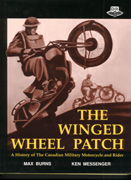The Winged Wheel Patch
A collection of anecdotal memories of riders from many different units, also featuring a large number of photographs, and a section on the technical details of the various motorcycles.
Author's Description[1]
The Winged Wheel Patch is more than a book about military motorcycles. Not long into the twentieth century, the motorcycle and its rider became an integral part of Canada's military establishment, a fact that has largely been overlooked by both motorcycle buffs and historians. Dedicated bike enthusiasts tend to focus solely on the machine, forgetting that the motorcycle more than any other vehicle is inseparable from its operator. In motion, the two are interdependent, like Siamese twins.
Historians tend to treat both rider and machine as quaint sideshows, like the clown at a rodeo or the cartoon before the feature. Yet, as readers can judge for themselves, in the theatre of conventional warfare the motorcycle and rider formed as much a part of the feature as the tanks and infantry, the bombs and bullets, and the dead and survivors.
The Winged Wheel Patch is not a review of Canada's military role in the twentieth century. Instead, it is an attempt to fill in some of the motorcycle and rider "missing links" apparent in the documentation of that history. While a regiment's history can be traced with relative ease, Despatch Riders (DRs) and other military motorcyclists became lost in the paper work they delivered with such dedication. In 1985, spurred into action out of a mutual interest in vintage motorcycling, Ken Messenger and Max Burns began collecting snippets of information scattered throughout countless books, dusty war diaries, and memories of military riders.
Originally they had hoped to gather enough data to put together a cursory look at the Canadian military motorcycle. But during the six years they ended up investing into the work, it developed into much more. They observed an overwhelming feeling among the veterans who answered Ken's and Max's requests for information that the DR's contribution to the nation had been for the most part ignored. Ken and Max could not help but agree.
"It is not our intention to glorify these soldiers or the wars they participated in," the book states in the preface. "The futility of humanity's conflicts is readily apparent. What is perhaps not so obvious is that when the veterans in this book went to war, they did so firmly believing that what they were doing was right, that the sacrifices they made were for the benefit of future generations, generations to which we the authors and our children belong. The close comradeship that evolves from facing death with a friend, the strength of a nation united in cause, the sheer right of it all is rarely duplicated outside a theatre of war. Those who survived the wars brought back memories framed in time and injuries to a world that would not, and could not, understand."
So the authors aimed for two goals with this book—to document the history of the military motorcycle and rider in a manner more accurate and detailed than any effort to cover the subject to date, regardless of the nation addressed, and to say thanks. No glory, just thanks.
